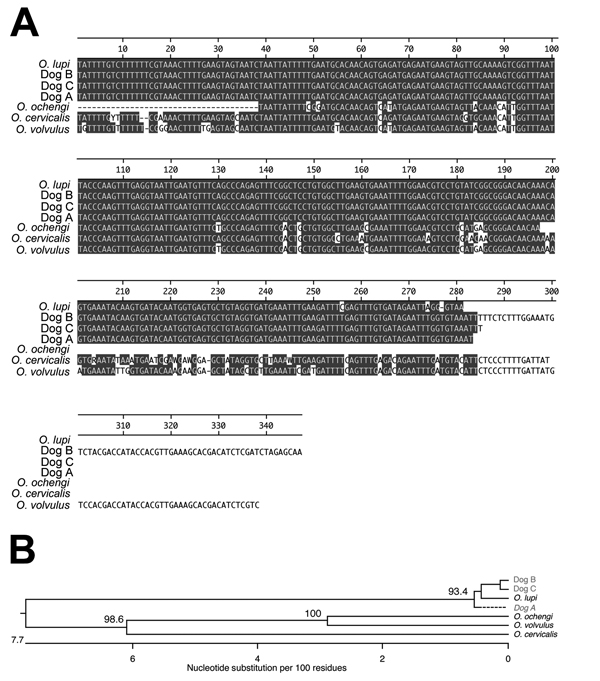Isolation of Onchocerca lupi in Dogs and Black Flies, California, USA
Hassan K. Hassan
1, Shanna Bolcen
1, Joseph Kubofcik, Thomas B. Nutman, Mark L. Eberhard, Kelly Middleton, Joseph Wakoli Wekesa, Gimena Ruedas, Kimberly J. Nelson, Richard Dubielzig, Melissa De Lombaert, Bruce Silverman, Jamie J. Schorling, Peter H. Adler, Thomas R. Unnasch

, and Emily S. Beeler
Author affiliations: University of South Florida, Tampa, Florida, USA (H.K. Hassan, S. Bolcen, T.R. Unnasch); National Institute of Allergy and Infectious Diseases, Bethesda, Maryland, USA (J. Kubofcik, T.B. Nutman); Centers for Disease Control and Prevention, Atlanta, Georgia, USA (M.L. Eberhard); San Gabriel Valley Mosquito and Vector Control District, West Covina, California, USA (K. Middleton, J.W. Wekesa, G. Ruedas, K.J. Nelson); University of Wisconsin, Madison, Wisconsin, USA (R. Dubielzig, M. De Lombaert); Complete Animal Eye Care, Sherman Oaks, California, USA (B. Silverman); Eye Clinic for Animals, San Diego, California, USA (J.J. Schorling); Clemson University, Clemson, South Carolina, USA (P.H. Adler); Los Angeles County Department of Public Health, Los Angeles, California, USA (E.S. Beeler)
Main Article
Figure 2

Figure 2. Molecular identification of parasites collected from 3 dogs in southern California, USA, by using sequence from the rRNA internal spacer (ITS). A) Multiple sequence alignment of ITS sequences from the 3 dogs and sequences from various Onchocerca parasites. Gray shading indicates areas of sequence identity. B) Unrooted phylogeny of the sequences shown in panel A. Numbers refer to the percentage of times the grouping distal to the number was supported in a bootstrap analysis of 1,000 replicate datasets. GenBank accession numbers for the sequences used in the alignment and phylogeny were as follows: O. lupi, JX489168; dog B, KC763782; dog C, KC763781; dog A, KC763779; O. ochengi, DQ523781; O. cervicalis, U13678; O. volvulus, AF325546. Scale bar indicates nucleotide substitutions per 100 residues.
Main Article
Page created: April 18, 2015
Page updated: April 18, 2015
Page reviewed: April 18, 2015
The conclusions, findings, and opinions expressed by authors contributing to this journal do not necessarily reflect the official position of the U.S. Department of Health and Human Services, the Public Health Service, the Centers for Disease Control and Prevention, or the authors' affiliated institutions. Use of trade names is for identification only and does not imply endorsement by any of the groups named above.
